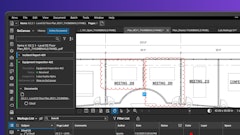
While the construction industry has traditionally been slow to adopt technology, innovative solutions are making that hesitation a thing of the past. From GPS to telematics, emerging tech offers contractors the ability to track equipment, utilize data and get work done like never before.
For Construction Pros spoke with Trimble senior director Aviad Almagor about one of the most frequently discussed advancements in construction tech: autonomous robotics. Almagor explains that autonomous robotics offer contractors in the construction industry significant benefits in the vein of efficiency, cost savings and safety.
What Are Autonomous Robots?
Autonomous robots are machines that can perform tasks without the need for human operation. A widely known example of this technology is the Roomba vacuum cleaner. From robotic mowers in lawn care to autonomous equipment in construction, robotics are now being developed and utilized to maximize productivity in virtually every industry.
Almagor says, “Field robotics is quite a wide field, but I think that there are three groups of technologies involved. It's about perception, guidance and bio-inspired technologies.” He continues, “A critical capability for a robotic system is the ability to move around and find its way from point A to point B.”
Safety
Perhaps the most important benefit of robotic technology on construction sites is safety, says Almagor. He explains that construction site conditions can often be dark, dirty and/or dangerous.
Almagor says, “First and foremost, robotics are about improving safety. Considering the fact that about 20% of work-related injuries in the U.S. occur on construction sites, there's a huge potential here.”
From drones to field robotics, this technology is being used to perform jobs in areas that are dangerous for human workers. Jobs such as site surveying, materials management, inspections and progress reporting can be managed by remote-controlled, autonomous machines – keeping company owners from having to send people out on dangerous terrain to do the intervention.
Efficiency
As robotic technologies and capabilities continue to advance, they could have a dramatic impact on construction site efficiency. The ability for machines to perform repetitive tasks while humans work on the more in-depth parts of the job can lead to optimized project completion.
“We are talking about technologies that allow autonomous or semi-autonomous systems to support humans,” says Almagor.
He goes on to say, “We can start with a very basic example: the Trimble Robotic Total Station. The Total Station can be operated remotely. It enables one person instead of two to take measurements and perform significantly more work in less time compared to the traditional surveying process.”
Almagor also says this results in improved productivity because you need just one person onsite to take measurements, while other workers are free to focus on other essential tasks. He says, “It is about productivity and safety – you need just one person onsite – but it's also about freeing the project team so they can focus on other more essential tasks. The value proposition in this case is about efficiency and productivity improvements.”
Cost Savings/Increased Profits
In utilizing robotic machines to boost efficiency and improve safety, construction company owners can also see significant cost savings and profit increases. This could occur for a number of reasons, including:
- The ability to avoid having to use paid workers for repetitive tasks.
- Your workforce completing more projects in shorter timeframes.
- Streamlined operations that lead to better asset management.
- Reduced expenses from worksite accidents.
Humans and Robots Working Together
While discussions of robotics frequently lead to workers worrying about lost jobs for humans, experts such as Aviad Almagor offer a different outlook. Almagor suggests that field robotics simply take care of time-consuming, repetitive tasks and dangerous jobs – freeing up workers to focus on the important things.
Almagor says, “Technology might make some jobs redundant, but at the same time, it is usually creating new ones and will free team members to be more creative and perform demanding tasks.” Innovations such as robotic technology continue to push the construction industry forward in exciting ways, but certain jobs and duties will always require a human touch.



















